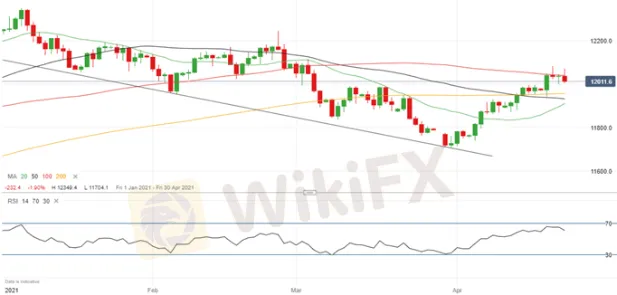简体中文
繁體中文
English
Pусский
日本語
ภาษาไทย
Tiếng Việt
Bahasa Indonesia
Español
हिन्दी
Filippiiniläinen
Français
Deutsch
Português
Türkçe
한국어
العربية
Euro Forecast: EUR/USD Outlook Still Constructive After Break Above 1.20
Abstract:FUNDAMENTAL EURO FORECAST: NEUTRAL - Near-term, EUR/USD will likely pause for breath after breaching the 1.20 level last week for the first time since March 4. - After that, however, further strength is possible, with the February 25 high at 1.2243 still a sensible longer-term target. - In the meantime, the end of the coming week is packed with Eurozone economic data that could provide further evidence that the next move will be upwards, or change the outlook to a more negative one.
The outlook for EUR/USD remains rosy after last weeks break above 1.20 for the first time since early last month but there could be a delay of a few days or more as the bulls realize their gains before reinstating long positions.
Overall, there is still demand for “risk-on” assets such as global equities – and less demand for safe havens like the US Dollar – as the world economy recovers from the slump caused by the coronavirus pandemic. However, news of record infections in India and further restrictions in Japan has reemphasized that there are still risks to the outlook and European Central Bank President Christine Lagarde was therefore predictably cautious at her press conference last week after the ECB left all its monetary policy settings unchanged as expected.
A further advance in EUR/USD is therefore by no means guaranteed, even though the EU vaccination program has picked up after a slow start and helped allay fears that economic growth in the EU will lag behind the growth of economies like the US and the UK. Still, the path of least resistance for the currency pair is upwards, particularly if the hawks on the ECB continue to press for a tightening of policy in the months ahead.
EUR/USD PRICE CHART, DAILY TIMEFRAME (JANUARY 4 – APRIL 22, 2021)
Turning to the economic calendar, the main event in the coming week will be Wednesday‘s decision on US monetary policy by the Federal Open Market Committee, and that could certainly provide some direction for EUR/USD. The risk for EUR/USD bulls is principally that the Fed will be unexpectedly hawkish, giving USD a lift. However, the week is also packed with Eurozone data, starting with Monday’s Ifo index of German business conditions, expected to increase to 97.6 in April from 96.6 in March.
Most of the potentially market-moving numbers are released on Thursday and Friday, however – after the Fed has released its statement. These include unemployment and sentiment figures but it will be inflation and GDP data that attract most attention.
Analysts predict a rise in German inflation in April to 1.8% year/year from 1.7% the month before, and an increase in the Eurozone as a whole to 1.6% from 1.3%. Numbers like these would not raise concerns at the ECB, even among the hawks, but if they are substantially higher than predicted then the hawks will likely raise the alarm.
Fridays “flash” first-quarter economic growth figures will likely have less of an impact. GDP data are generally seen as backward-looking so not market moving and that should be no different this time even given the current focus on growth. In Germany, an improvement to -3.2% year/year from the previous -3.7% is predicted.
==========
WikiFX, a global leading broker inquiry platform!
Use WikiFX to get free trading strategies, scam alerts, and experts experience!
╔════════════════╗
Android : cutt.ly/Bkn0jKJ
iOS : cutt.ly/ekn0yOC
╚════════════════╝

Disclaimer:
The views in this article only represent the author's personal views, and do not constitute investment advice on this platform. This platform does not guarantee the accuracy, completeness and timeliness of the information in the article, and will not be liable for any loss caused by the use of or reliance on the information in the article.
Read more

Weekly Fundamental Gold Price Forecast: Hawkish Central Banks a Hurdle
WEEKLY FUNDAMENTAL GOLD PRICE FORECAST: NEUTRAL

Gold Prices at Risk, Eyeing the Fed’s Key Inflation Gauge. Will XAU/USD Clear Support?
GOLD, XAU/USD, TREASURY YIELDS, CORE PCE, TECHNICAL ANALYSIS - TALKING POINTS:

British Pound (GBP) Price Outlook: EUR/GBP Downside Risk as ECB Meets
EUR/GBP PRICE, NEWS AND ANALYSIS:

Dollar Up, Yen Down as Investors Focus on Central Bank Policy Decisions
The dollar was up on Thursday morning in Asia, with the yen and euro on a downward trend ahead of central bank policy decisions in Japan and Europe.
WikiFX Broker
Latest News
Elderly Trader Loses RM2.1M in WhatsApp Forex Scam
Spotware Unveils cTrader Store, Global Marketplace for Algo Creators
Gigamax Scam: Tracking Key Suspects in RM7 Million Crypto Fraud
WikiFX Review: Is IQ Option trustworthy?
CFI Partners with MI Cape Town, Cricket Team
Doo Financial Expands Reach with Indonesian Regulatory Licenses
Quadcode Markets: Trustworthy or Risky?
5 Questions to Ask Yourself Before Taking a Trade
Avoid Fake Websites of CPT Markets
Webull Canada Expands Options Trading to TFSAs and RRSPs
Currency Calculator


